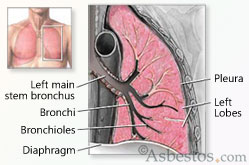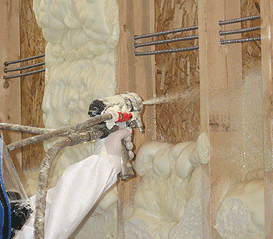Paul James
September 26th is National Mesothelioma Awareness Day and we at Asbestos.com are trying to raise awareness as much as possible. The support we have received from eco bloggers, Realtors, and other organizations has been absolutely tremendous. As you may know, homes built before 1980 likely have asbestos insulation in them. When homeowners remodel, they may expose themselves to asbestos, which could lead to a fatal cancer known as mesothelioma. There are many environmentally sustainable, healthy and GREEN ways to insulate your home and this is among the topics we’d like to discuss.

With a growing amount of education and technology in eco-sustainable resources, many cities and states are leading the way towards a green paradigm of building and construction. Environmental efficiency is on the rise because of technology and green building methods progressing rapidly. Not only will these methods produce a healthier lifestyle, it will save you money.
We’re all aware of the benefits of utilizing environmentally sustainable green roofs, including: improvement of the urban heat island effect and even reduction of annual energy usage and costs. And studies have shown that a green roof’s ability to retain water can greatly aid in an environment’s stormwater management policy because less water is released back into a city’s already overburdened sewer infrastructure, and that which does runs off slower, cooler, and cleaner.
The implementation of eco-construction and green energy solutions will play an important role in the transformation to a healthier and sustainable world. We can all agree that green construction is healthy for a building’s occupants all around, from top to bottom and in-between.
Asbestos Info & Tips
Used throughout the 20th century as a form of insulation for piping, roofing, and flooring, asbestos’ flame resistant and highly durable qualities made it an ideal choice for manufacturers, before we knew of the potential hazards. Many older homes built prior to 1980 may still harvest obsolete and corrosive building materials which can create health concerns.
If any asbestos is located in your home, the best thing to do is leave it un-disturbed until a home inspector can determine the best course of action. In many situations, the best action is no action. Asbestos that is disturbed or damaged due to age is known as “friable“ asbestos. This is a concern because its toxic fibers can easily circulate and become inhaled. The removal of asbestos from specified locations must be undertaken by abatement contractors who are licensed in their corresponding states.
Although asbestos exposure does not always lead a related illness, long term inhalation of its fibers can cause a rare but severe ailment known as mesothelioma. Due to the fact many mesothelioma symptoms are similar to less serious ailments, diagnosis is one of the more difficult tasks physicians encounter.

Recently, congress passed the American Recovery and Reinvestment Act. Included in this act were extensions to the tax incentives placed for energy efficiency in 2005, as well as new credits for homeowners who remodel or build using eco-sustainable methods. Some of the measures that are eligible for tax credits include added insulation to walls, ceilings, or other part of the building envelope that meets the 2009 IECC specifications, sealing cracks in the building shell and ducts to reduce heat loss. Storm doors paired with U-factored rated wood doors are also eligible.
 There are many green, eco-friendly materials that replace the need for asbestos and can reduce energy costs annually. There is no need for any products used in construction to be made from asbestos, yet over 3,000 work and home-based materials still contain this toxin.
There are many green, eco-friendly materials that replace the need for asbestos and can reduce energy costs annually. There is no need for any products used in construction to be made from asbestos, yet over 3,000 work and home-based materials still contain this toxin.
Green alternatives to asbestos include the use of cotton fiber, lcynene ® foam and cellulose. These green options have the same beneficial qualities as asbestos, minus the health deteriorating and toxic components. 
In this time of global awareness accumulating rapidly, implementing eco-friendly forms of building and construction is becoming a must for homeowners. Many locations throughout the United States and beyond are swiftly changing their construction practices to suit both the environment and the health of human beings, inside and out.
~ Paul James, Awareness Coordinator at the Mesothelioma Cancer Center, www.asbestos.com, paul@asbestos.com.
Asbestos.com is committed to providing the latest, up-to-date information to our visitors in the hopes of spreading awareness about the dangers of asbestos cancer. This website offers a one-stop resource on all asbestos issues ranging from occupational exposure to mesothelioma treatment options. As the leading asbestos and mesothelioma resource, Asbestos.com offers more than 3,000 pages of the most comprehensive and cutting edge information on the web.
For additional info, please contact Paul or Ben Grayson, National Awareness Coordinator, Mesothelioma Center at: 407.965.5755.
 Greenroofs.comConnecting the Planet + Living Architecture
Greenroofs.comConnecting the Planet + Living Architecture





Augusto
Thanks for the article. We are a manufacturer of Cellulose Insulation. We believe in safe building products. We are doing our part to make a safe, reliable product that out performs and is greener than any other Insulation produced today. If you have any questions about Cellulose Insulation I would be glad to give you back ground on our Industry and our efforts to compete against other insulation that is not so green. Best Wishes.
Hasham
Yes homes built before 1980 are at great risk of asbestos lung cancer mainly arising from homes built in the periods of World War II where Asbestos was very popular for insulation & fireproofing of ships, warcraft; war vessels. Here’s some more information about asbestos in old buildings from http://www.researchmalignantmesothelioma.com
If a home was built after 1980, it is safe to assume the home has no asbestos in it. However, older homes that were built prior to 1980, especially those built after World War II have great risk of containing asbestos products. Asbestos alone is not harmful; however it can become dangerous if tiny asbestos fibers become airborne (disturbed into the air). Asbestos fibers were mixed with a wide variety of construction products used in older homes. Examples include cement, wood pulp and paint. One of the best traits of Asbestos is its ability for being fire proof. Between World War II and the 1980s, fireproofing was very important including fireproofing buildings, homes, public schools and government offices. If the cement, wood pulp and paint in older homes are not damaged and remain in good shape, there is relatively low risk of asbestos exposure. However, for instance if the paint is peeling off or the cement is damaged, then there is more risk of asbestos fibers becoming airborne. The image on the left is of an old Asbestos home damaged after Hurricane Katrina. If you notice, the walls; the paint of the house that contain asbestos products have been damaged, which can easily make asbestos fibers airborne. If these tiny airbone asbestos fibers are breathed into the lungs by oncomers, they could be at risk of developing asbestos related cancers such as mesothelioma; asbestosis. The reason this home was built with asbestos containing products such as asbestos tiles, asbestos sidings, shingles and insulation is because these products were thought to be safe and strong for a good foundation of the house.
Nathan Capuano
I bookmarked this blog a while ago because of the good content and I have never been disappointed. Continue the good work.